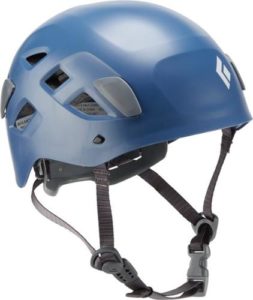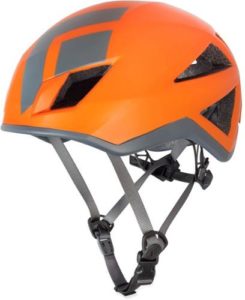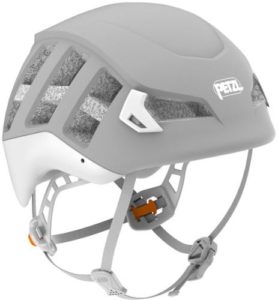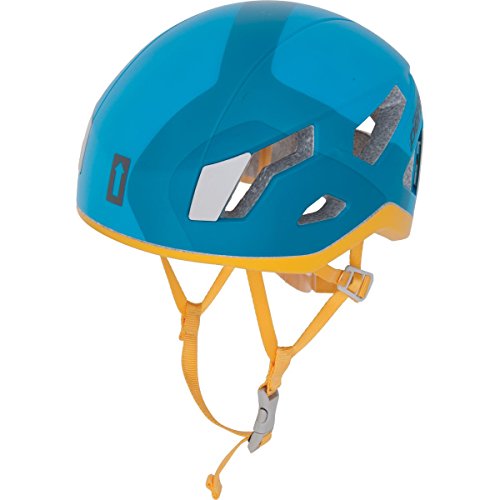Love climbing rock faces outdoors, but worried about protecting your most important asset – your head? Since time immemorial, climbers’ heads have come under threat from rockfall, or by being struck during an awkward sideways or upside down fall. There are a myriad of helmet options, but which one is the best climbing helmet for the type of climbing that interests you?
One of our big goals here at The Adventure Junkies is to make your life easier when it comes to gearing up for climbing. Whether you’re after something light, durable, or inexpensive, we’ll walk you through a selection of the best products on the market and show you how to choose the best climbing helmet for you.
For more of our top climbing gear recommendations, check out the Best Climbing Tape.
Quick Answer - The Best Climbing Helmets
- Black Diamond Vision MIPS
- Black Diamond Half Dome
- Petzl Sirocco
- Black Diamond Vapor
- Petzl Boreo
- Black Diamond Vector
- Petzl Meteor
- Mammut Wall Rider
- Singing Rock Penta
Comparison Table - Best Climbing Helmet
For the best experience turn your device horizontally| Name | Weight | Material | Price | Rating | Review |
|---|---|---|---|---|---|
| Black Diamond Vision MIPS | 8.46 oz | Polycarbonate, ABS | $$$ | 4.9 | Read Review |
| Black Diamond Half Dome | 11 oz | EPS Foam with a Hard Plastic Shell | $ | 4.5 | Read Review |
| Petzl Sirocco | 5.8 oz | EPP (Expanded Polypropylene) Foam | $$$ | 4.0 | Read Review |
| Black Diamond Vapor | 7 oz | EPS Foam with Polycarbonate Shell | $$$ | 4.7 | Read Review |
| Petzl Boreo | 10.4 oz | ABS | $ | 4.4 | Read Review |
| Black Diamond Vector | 8.5 oz | EPS Foam with Polycarbonate Shell | $$ | 4.6 | Read Review |
| Petzl Meteor | 7.9 oz | EPS Foam with Polycarbonate Shell | $$ | 3.6 | Read Review |
| Mammut Wall Rider | 6.9 oz | EPP Foam with Polycarbonate and Hard Plastic Shell | $$ | 5.0 | Read Review |
| Singing Rock Penta | 7.23 oz | EPS Foam with a Polycarbonate Shell | $ | 4.5 | Read Review |
| Name | Weight | Material | Price | Rating | Review |
Reviews - The Best Helmets for Climbing
Black Diamond Vision MIPS
Specs
- Material: Polycarbonate, ABS
- Weight: 8.46 oz
Features
- MIPS reduces rotational impact from angled crashes
- Large outer shell with EPS foam for added crown protection
- EPP body resists breaking over multiple impacts
- Low-profile headlamp clips
- Adjustable suspension system and removable padding provide a secure fit
BEST OVERALL CLIMBING HELMET
PROS: Combination of EPS and EPP foam makes it more durable than comparable alternatives.
CONS: Under-ear strap is not adjustable.
Black Diamond Half Dome
Specs
- Material: EPS Foam with a Hard Plastic Shell
- Weight: 11 oz
Features
- Internal headband adjustable with one hand via a single dial
- Vents on sides and back
- Headlamp clips
BEST FOR: CLIMBING WHERE THERE MIGHT BE ROCKFALL
PROS: Durable, great protection, cheap
CONS: Heavy, minimal ventilation, not the most comfortable
Petzl Sirocco
Specs
- Material: EPP (Expanded Polypropylene) Foam
- Weight: 5.8 oz
Features
- Ventilation all around the shell
- Magnetic chinstrap buckle that adjusts with one hand
- Foam inner that is removable and washable
- Clips for headlamp and a visor (not included)
BEST FOR: ALPINE AND BIG WALL CLIMBING
PROS: Lightest helmet on the market, comfortable, superb ventilation
CONS: Expensive, not as strong as a hard plastic shell, only available in bright orange
Black Diamond Vapor
Specs
- Material: EPS Foam with Polycarbonate Shell
- Weight: 7 oz
Features
- Ventilation all around the shell
- Molded push buttons
- Ratchet adjuster to fine-tune fit
- Clips for headlamp
BEST FOR: ALPINE AND BIG WALL CLIMBING
PROS: Great ventilation, comfort and adjustability without compromising on safety
CONS: Expensive, not as strong as a hard plastic shell
Petzl Boreo
Specs
- Material: ABS
- Weight: 10.4 oz
Features
- Hybrid construction with thick ABS crown, EPP foam liner
- Hard outer shell resists impact and abrasion, and offers reinforced protection against lateral, front and rear impacts
- Optimized volume and wide ventilation holes
- 4 clips offer secure headlamp attachment
BEST FOR: BEGINNER CLIMBERS
PROS: Lightweight for an entry-level helmet
CONS: Adjustability is seriously poor compared to the other options on this list
Black Diamond Vector
Specs
- Material: EPS Foam with Polycarbonate Shell
- Weight: 8.5 oz
Features
- Ventilation all around the shell
- Molded push buttons
- Ratchet adjuster to fine-tune fit
- Clips for headlamp
BEST FOR: ALL CLIMBING FROM CRAGGING TO THE ALPINE
PROS: Great ventilation, comfort and adjustability without compromising on safety
CONS: Not as strong as a hard plastic shell
Petzl Meteor
Specs
- Material: EPS Foam with Polycarbonate Shell
- Weight: 7.9 oz
Features
- Ventilation all around the shell
- Magnetic chinstrap buckle that adjusts with one hand
- Breathable foam lining
- Clips for headlamp
BEST FOR: ALL CLIMBING FROM CRAGGING TO THE ALPINE
PROS: Well-ventilated, comfortable, easily adjusted
CONS: Not as strong as a hard plastic shell
Mammut Wall Rider
Specs
- Material: EPP Foam with Polycarbonate and Hard Plastic Shell
- Weight: 6.9 oz
Features
- Partial hard plastic shell for the front-center part of the head
- Ventilation all around the shell
- Adjustable chin and rear straps
- Clips for headlamp
Singing Rock Penta
Specs
- Material: EPS Foam with a Polycarbonate Shell
- Weight: 7.23 oz
Features
- Large padded foam lining for comfort
- Large ventilation holes
- Headlamp clips
- Adjustable straps for best fit
BEST FOR: ALPINE ROCK, BIG WALL CLIMBING, OR ICE CLIMBING
PROS: Ultralight, cheap, well-ventilated, easy-to-use headlamp clips
CONS: Not as strong as a hard plastic shell, not the easiest to adjust
HOW TO CHOOSE THE BEST CLIMBING HELMETS
PROTECTION
Rocks are solid, so helmets need to be made of suitable material to protect you from them. All helmets meet an industry standard of protection, with greater protection from overhead impact than from the side. Most helmets are usually made of a hard plastic shell, or a thick layer of lightweight foam with a polycarbonate shell. A plastic shell is considered to be more durable and longer lasting, but what it offers in safety, it compromises on weight and comfort.
WEIGHT AND COMFORT
Some like them thin and light. Some like them thick and heavy. Choosing the right climbing helmet for you will depend on your goals. If you’re developing new climbs in new areas, then a heavier, plastic-shell helmet will offer more protection from rockfall. A lighter helmet may be better if you’re climbing longer routes that are relatively well traveled, as rockfall is less likely. If you’re new to climbing, a bit of weight difference isn’t going to matter all that much.
VENTILATION
Sometimes climbers will want to wear a helmet all day. Other times simply for an hour or two. Melting under a helmet with little ventilation in a hot, humid climbing area is no fun for anyone. But neither is alpine climbing in a frigid stratosphere in a helmet with more ventilation gaps than an open window. Pick the right amount of ventilation for the type of climb you’re most psyched on.
ADJUSTABILITY
Climbers traverse lots of variable terrain and climates, and sometimes wear woolen beanies of different thickness under their helmets. If you’re in an environment that may see you adjusting your helmet multiple times in a day, then it will make a great deal of difference to have one that is easy and intuitive to fine-tune.
READ MORE
For more of our top climbing gear recommendations, check out these popular buyer's guides:









